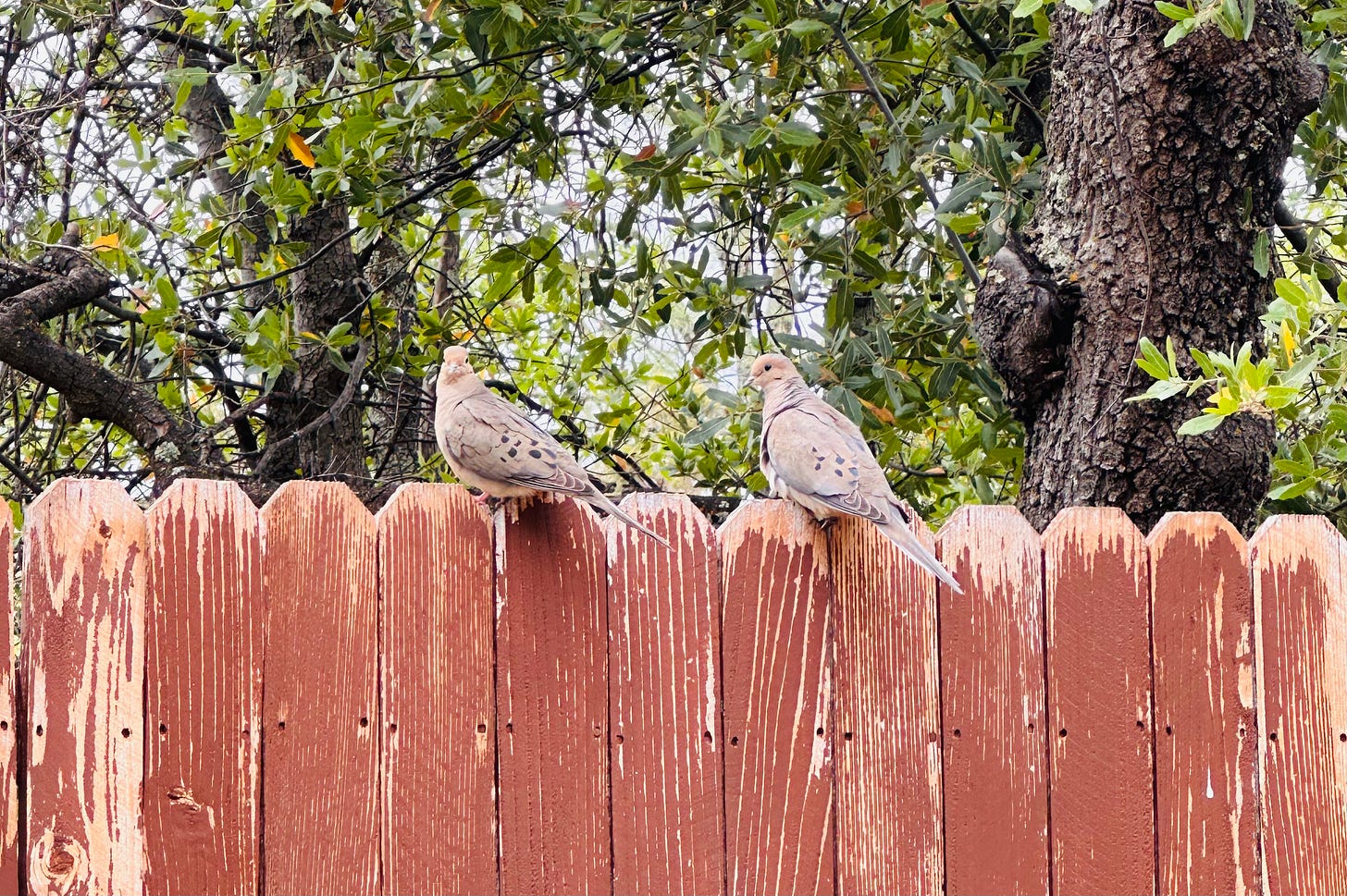
For most modern humans, bird sounds are either soothing background noises – the goldfinches’ serenades, the mourning doves’ cooing – or annoying nuisances – the crows’ grating caws, the Canada geese’s obnoxious honks – ultimately signifying nothing. For avid bird-watchers, bird sounds are exciting clues that an ash-throated flycatcher or a yellow-rumped warbler is in the vicinity – they signify the bird’s identity. But for the entire animal kingdom – including certain human groups who still live off the land as hunter-gatherers today – bird sounds contain a world of meaning about where there is danger and where there is safety, about who is around and where they are coming from. It’s about time we start tuning in.
In What the Robin Knows, Jon Young, a lifelong naturalist who has studied animal tracking with Indigenous groups across the world, provides a simple, practical, remarkably fruitful framework for learning to understand this bird language. It sounds woo-woo, almost magical, to be able to do this, but we, like all members of the animal kingdom, are evolutionarily hard-wired for it. With dedication and patience, Young insists we can learn not just to identify birds by their calls, but to understand what they signify.
Birds are the sentinels of the natural world, keenly aware and very vocal, often with viewpoints from high off the ground. They are always the first to know when a new creature is approaching a scene. All animals, from mammals to reptiles to other birds, react to bird’s alarm calls, since this can mean the difference between life and death for them. What the Robin Knows presents an extensive body of anecdotal and scientific evidence alike that demonstrate beyond all doubt that birds are conveying detailed information to each other and to other kinds of animals through their calls and behavior – their reaction to the presence of a bobcat entering their territory on foot is measurably different than their reaction to a Cooper’s hawk swooping in from overhead. Young, through decades of practice, has learned the difference, and insists that you can too.
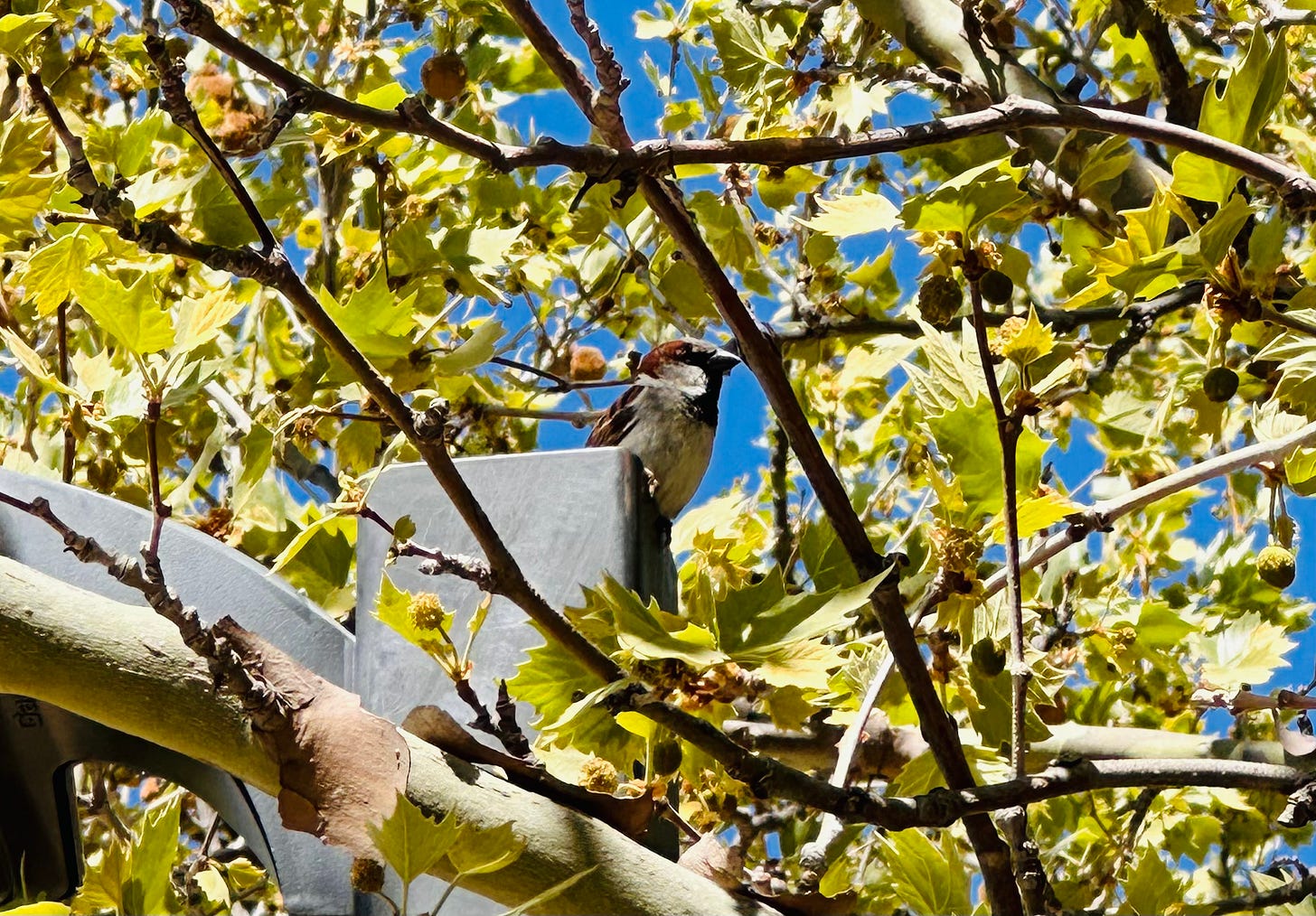
The San Bushmen, the incredible hunter-gatherers of southern Africa with whom Young has studied extensively, are just as tuned in to bird calls as the animals around us are, for they are vital tools for tracking large prey animals over dozens of miles. Birds react to a large creature fleeing into their territory in reliable patterns, the knowledge of which allows the Bushmen to follow prey animals' paths even when they are miles behind them.
Stories and studies alike offer many examples of crafty predators using their knowledge of bird alarm calls in creative ways for their own benefit. Blue jays have been seen mimicking the alarm calls of sparrows at a feeder, so that sparrows scatter to hide in the foliage and the jay can have the feeder to itself. Birds of prey engage in clever wake-hunting – if they hear small birds sounding an alarm call in the distance, they will head towards that area in hopes of catching the birds off-guard, while their focus is on some other predator. So much of the drama, the action of the natural world, is concealed from us if we don’t adopt the mindset of an animal trying to survive and perk up our ears to the bird sounds.
Interpreting the language of birds allows us to connect with the natural world on a much deeper level, and in a very practical sense, it enables us to see wildlife we ordinarily would never know was there. In his book, Young shares many incredible stories of birds cluing him into the presence of highly elusive animals we almost never just stumble upon – foxes, weasels, bobcats, owls, wolves, and more. In the unlikely event that a mountain lion is stalking you through the woods, it's worthwhile to know that the birds around you will notice this way before you will, and listening to them could save your life. More realistically, it simply delights us as nature lovers to observe elusive wildlife in their natural habitat.
All that is needed to begin learning bird language is attentiveness, receptivity, and a consistent spot to watch birds. Your “sit spot” as Young calls it could be in your yard, in a nearby park, in the woods, anywhere really – convenience is the priority, because ideally you will spend 30-40 minutes in this spot each day, looking and listening. While birdwatchers love the thrill of seeing new birds, students of bird language need to spend a lot of time with very familiar birds – the omnipresent robins, cardinals, finches, sparrows, and the like. Learning a lot about the sounds and body language of these birds that are everywhere will allow you to pick up on clues and benefit from their wisdom and awareness everywhere you go.
Young’s bird language framework includes five major types of vocalizations. Four of them comprise the baseline, background noise of bird activity, that signals the environment is safe and all is well. The fifth one, the alarm call, signals a disturbance in the area – a bird-eating hawk flying overhead, a fox sneaking around on foot, a loud human barging through. The idea is to learn what baseline bird noises are really well, so that you can immediately sense the disturbance of alarm calls, just like the birds do, and eventually, distinguish between alarms that correspond with different types of threats.
The song is the first and most familiar type of bird sound. Birds sing their songs at daybreak and sometimes throughout when they are feeling comfortable, to announce their presence in their territory, or just to entertain themselves. Second, there are companion calls – little sounds that members of a breeding pair or sometimes a flock make back and forth to each other, to assure each other they are still there and all is well. Extremely wholesome. Third, there are the sounds of males defending their territory from other intruding males, a typical occurrence. Fourth, there are the sounds of juveniles begging their parents for food, from the nest or from the ground if they’re recent fledglings still dependent on the aid of their parents, like teenagers off at college using their parents’ credit card.
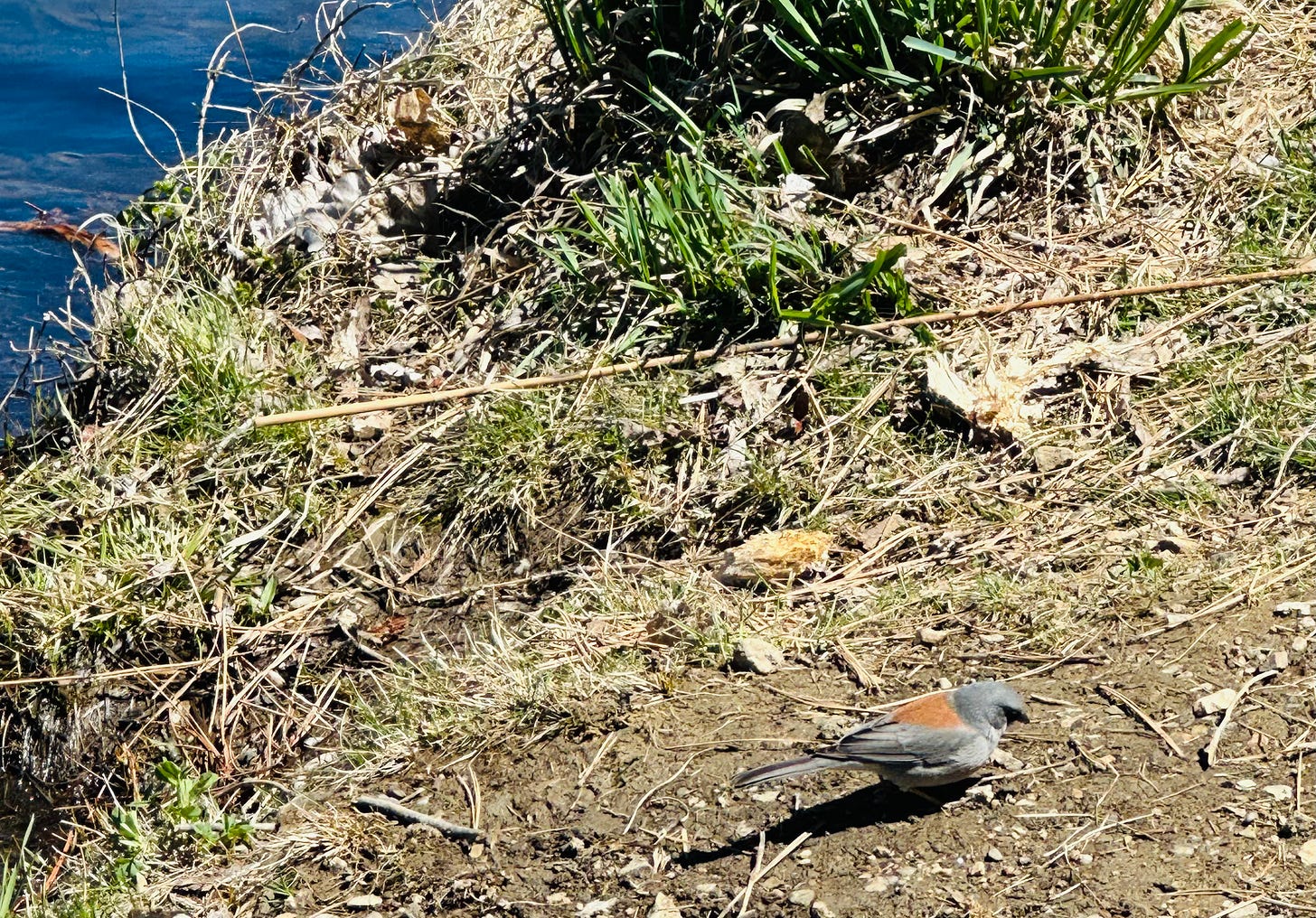
If you devote some time to observing the behavior of a common species of bird, the different sounds associated with these different events will become readily apparent. Though the book provides a lot of recordings to reference for these different types of calls, Young encourages folks to learn bird language from the birds themselves as much as possible, especially because there can be great regional and individual variation in all of these sounds. Picking one spot to visit day after day, you will see not just the same type of birds, but many of the same individual birds – outside of migration, most birds have a shockingly small territory where they roam and forage.
This framework is so effective and intuitive, the very first time I went birding with these five categories of sounds in mind, I saw several amazing things I’ve never seen before, thanks to what the birds told me.
On a Sunday morning, a few chapters into this book, I wanted to keep reading, but I was also dying to go on a bird walk and see if I could notice anything new by paying more attention to bird vocalizations and behavior. After some hemming and hawing, I decided to bird instead of read.
I walked across my street to the little neighborhood park, to walk the suburban trail that follows Butte Creek. Literally as soon as I began, I heard a very faint, strange clicking noise coming from a dark eyed junco in the bushes. I learned in Young’s book that this is one of the birds whose alarm call is very subtle, almost imperceptible, so I moved in closer to investigate. The adult flew away and there left behind was its fledgling, an adorable streaky bundle of feathers with a beak still too big for its face, old enough to be out of the nest but still too young to fly. The junco had been sounding its little alarm probably because I was so close to its vulnerable fledgling, which the parents still keep a close eye on until they can fly. Juncos are so common, I would never have stopped to look closely at this one if I hadn’t picked up that tiny alarm call. After letting me admire him for a few moments, the fledgling awkwardly hopped away from me deeper into the grass, and my heart melted.
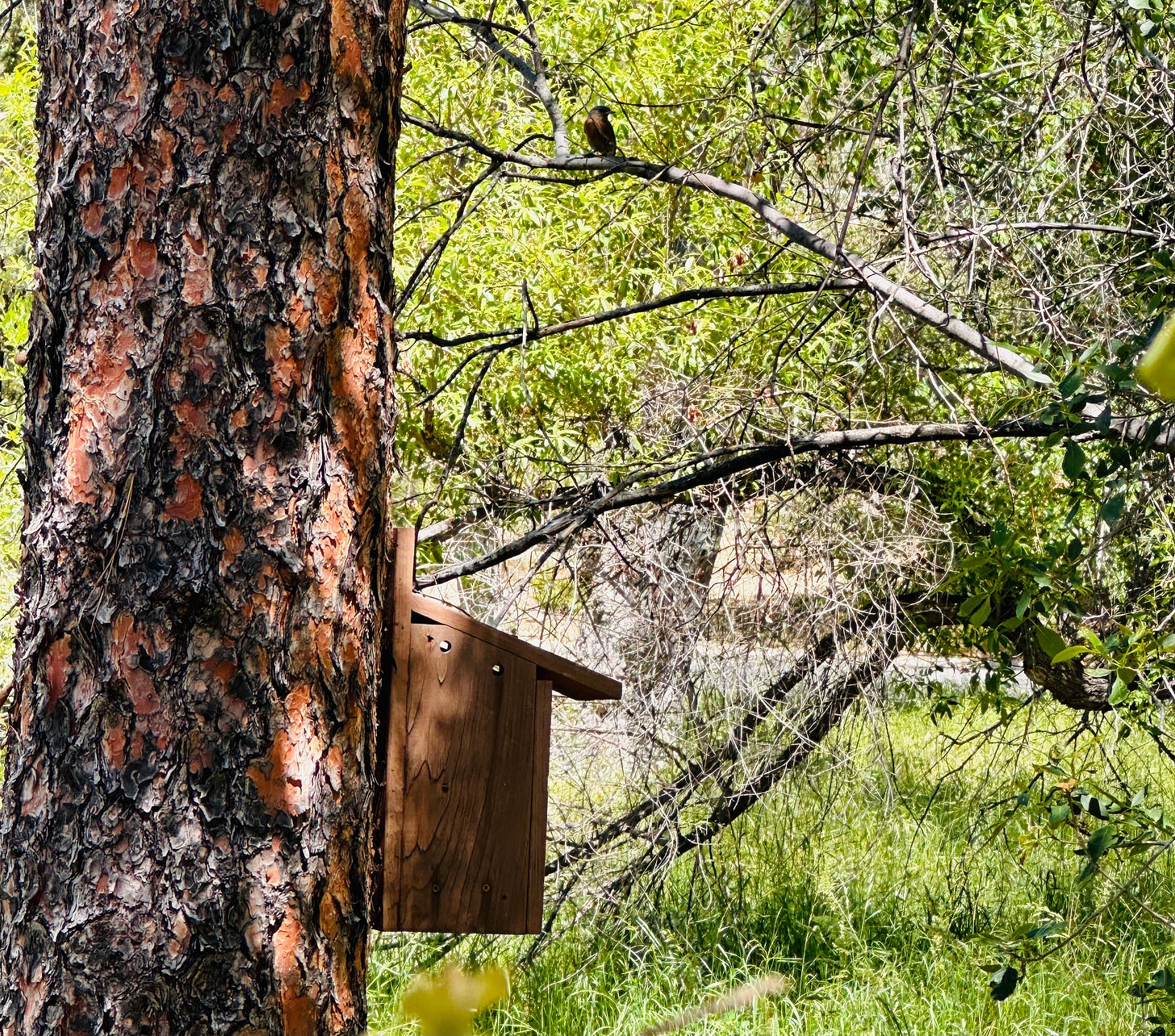
I continued on my way, greeting the proud mama bluebird who is constantly feeding her nestlings and guarding their nestbox just off a bend the trail. I crossed a road, and entered an open space beneath some Ponderosa pines. I heard the shrill alarm call of a robin, which I had learned from a recording while reading the book. I figured the robin was alarmed at me and scanned all the tree tops to try to find this distressed robin. I could not for the life of me spot him, though his call was so loud and clear he couldn’t have been more than a handful of yards away. Just as I was giving up and walking off the scene, something large moving in a tree across the street, near eye-level, caught my attention. It was unmistakably a raptor with a sharp beak and talons, probably a bird-hunting accipiter given the robin’s alarm and the raptor’s sneaky presence in the tree. I watched him in my binoculars for perhaps 10 seconds, and then he jumped further into the brush and I lost sight of him. At that exact moment, the robin’s alarm call ceased. Mere moments later, he had resumed his jubilant song.
Holy @#$%, this stuff really works! The robin was clearly sounding the alarms about this raptor that preys on smaller birds. I have maybe never felt more connected to nature than I did at that moment, from this encounter with a totally mundane neighborhood bird. I had never before seen a raptor hanging out near the ground in my neighborhood, and within 30 minutes of going on a walk with the birds’ calls in mind, a robin showed me one I never ever would have seen otherwise. Usually, I just walk right through that clearing without stopping, and I only barely noticed the hawk after three straight minutes of gawking about, trying to see the robin. In retrospect, I should have realized a robin living in a neighborhood would not have been that alarmed by my presence, but that of a more serious predator.
Riding high, completely beside myself at how well this bird language stuff was working, I reached the first golf course which the trail passes by. Just 20 feet away, there was a robin hopping around the grass with a meaty worm dangling out the sides of her beak. I carefully sat down on a rock to watch her, wondering if she was holding onto the worm rather than eating it to take it back to her nest of hungry hatchlings. A spotted towhee joined us, landing even closer to me, and the robin flew further away, but remained within view. An acorn woodpecker landed next to her, which was quite bizarre – woodpeckers usually forage for insects in trees, of course, not on the ground, and I couldn’t think of a time I’d seen one land on a lawn. He made a move for the robin, and I realized he was probably after her catch. She hopped away and swallowed the worm – better for her to have it than him.
The towhee made a little screech which I hear them make all the time, but that defies any attempt at transliterating – I don’t find written approximations of bird calls very useful anyways. I wondered if this lone towhee had a mate, and if so, where she was. Then, from the underbrush on the other side of the trail, I heard the same sound from another towhee. These two towhees went back and forth, calling and responding to each other at regular intervals every few seconds. My heart swelled realizing that he wasn’t alone, his mate was just over there and they were talking, checking in on each other, making sure the other wasn’t in any danger.
Sure, in this third scene, I may be guilty of excessively anthropomorphizing. But I think with the junco and the robin, it’s pretty undeniable that they broadcasted information with their calls which I interpreted accurately. I think my instincts at the golf course were right, that the story these birds conveyed to me with their calls and their behavior is the everyday drama of nature. But ultimately, time, much more time, with my neighborhood birds will reveal to me if I accurately interpreted this situation or not. I hope there is a day where I will hear a robin alarm and know immediately what the threat is and where.
And so, I’m a convert, a believer that I can and will unlock new amazing wildlife experiences the more I learn about and pay attention to bird language. I will take the esoteric leap from bird watcher to bird talker. My lingering skepticism was obliterated by the immediate revelations on that magical walk. What the Robin Knows is a powerful tool for enriching your time in nature whose five sound principles I will carry with me every time I’m outside, in hopes of learning more every day about the intricate connecting all of nature’s beings.
Even before reading this book, I had taken to spending some time each day sitting in my backyard in the vicinity of the bird feeders as I can, getting to know the cast of characters that frequent my yard, learning their voices and figuring out what they’re doing. I consider this post my sit spot for now. Stay tuned for an introduction to my backyard birds and what I’ve learned so far about what they’re doing and saying.
Tomorrow I leave on a four-day river rafting trip down Utah’s San Juan River, one of the biggest perks of my job to date. I’m hoping to see some new birds and learn a whole lot about the geology and human history of the area from the two brilliant professors joining us on the trip. Wish me luck on my first rafting adventure, and thanks for keeping an eye on things with me.




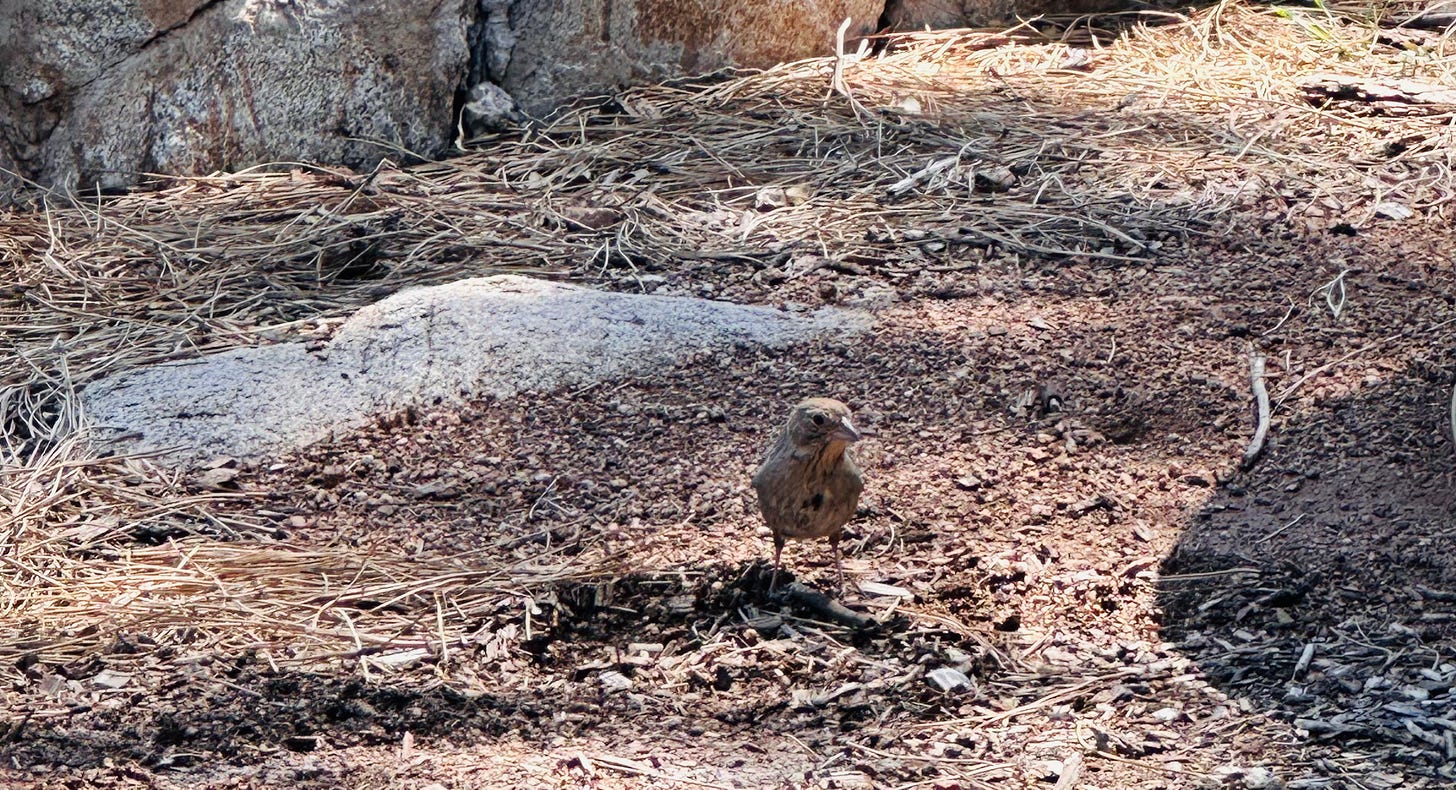
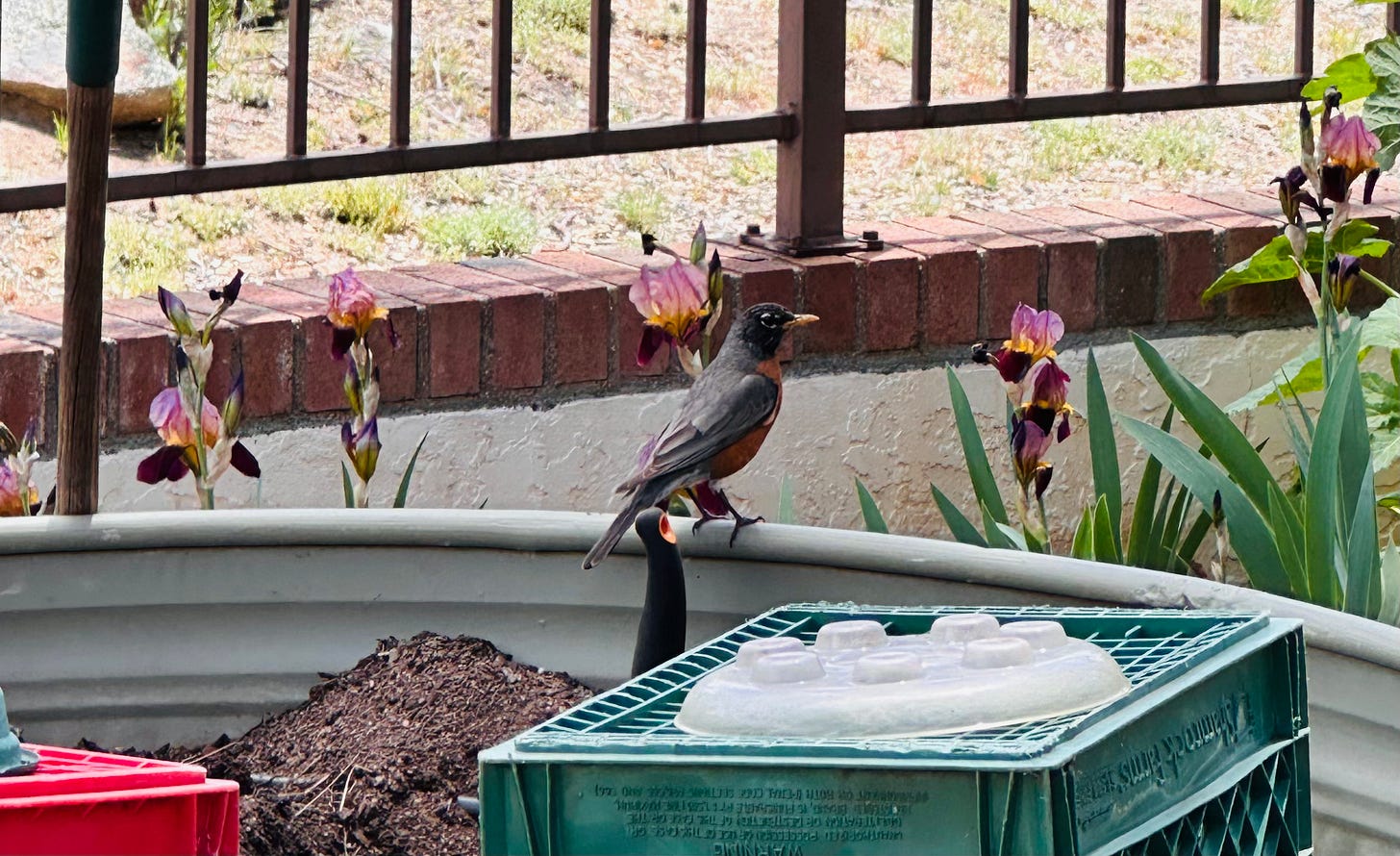
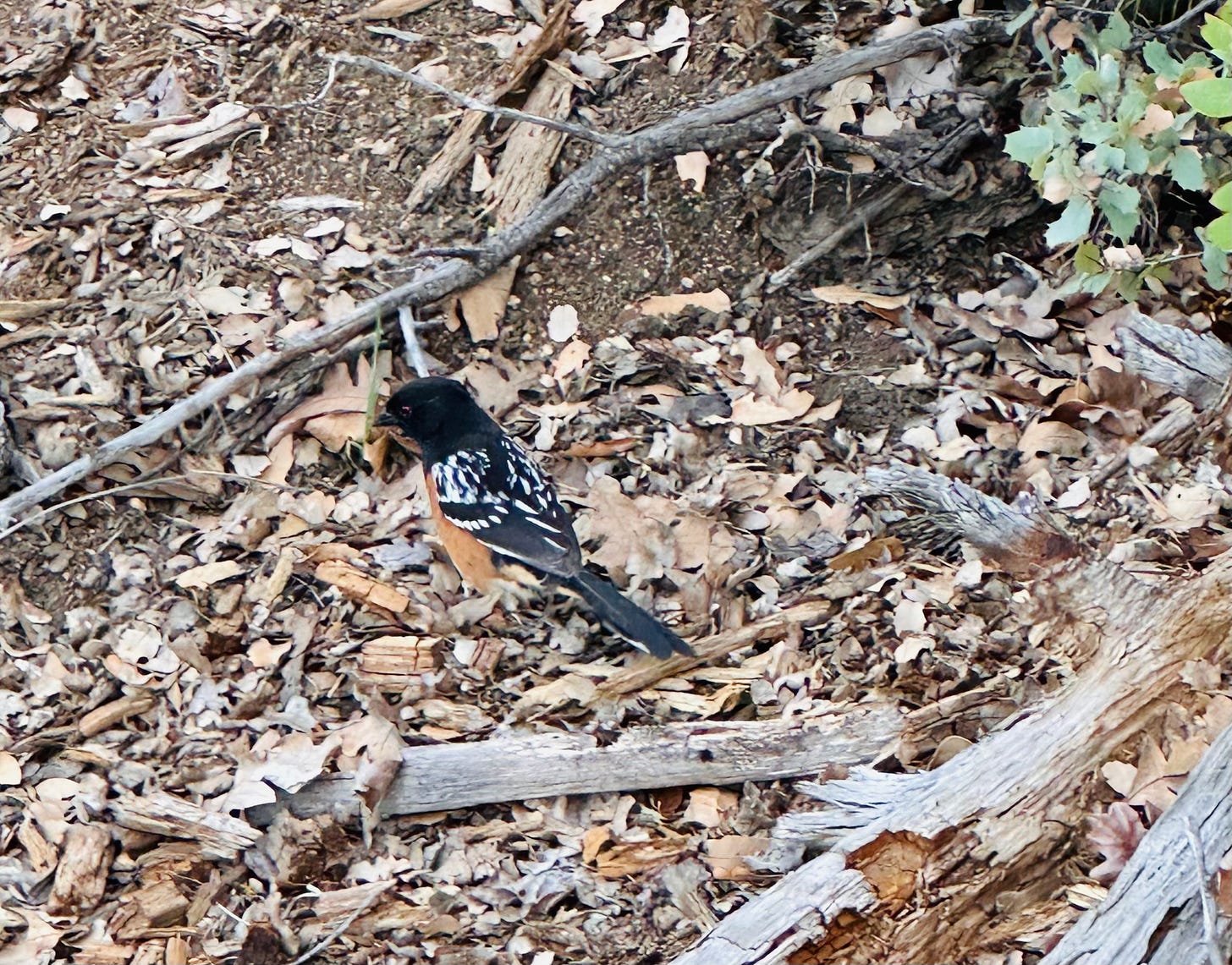
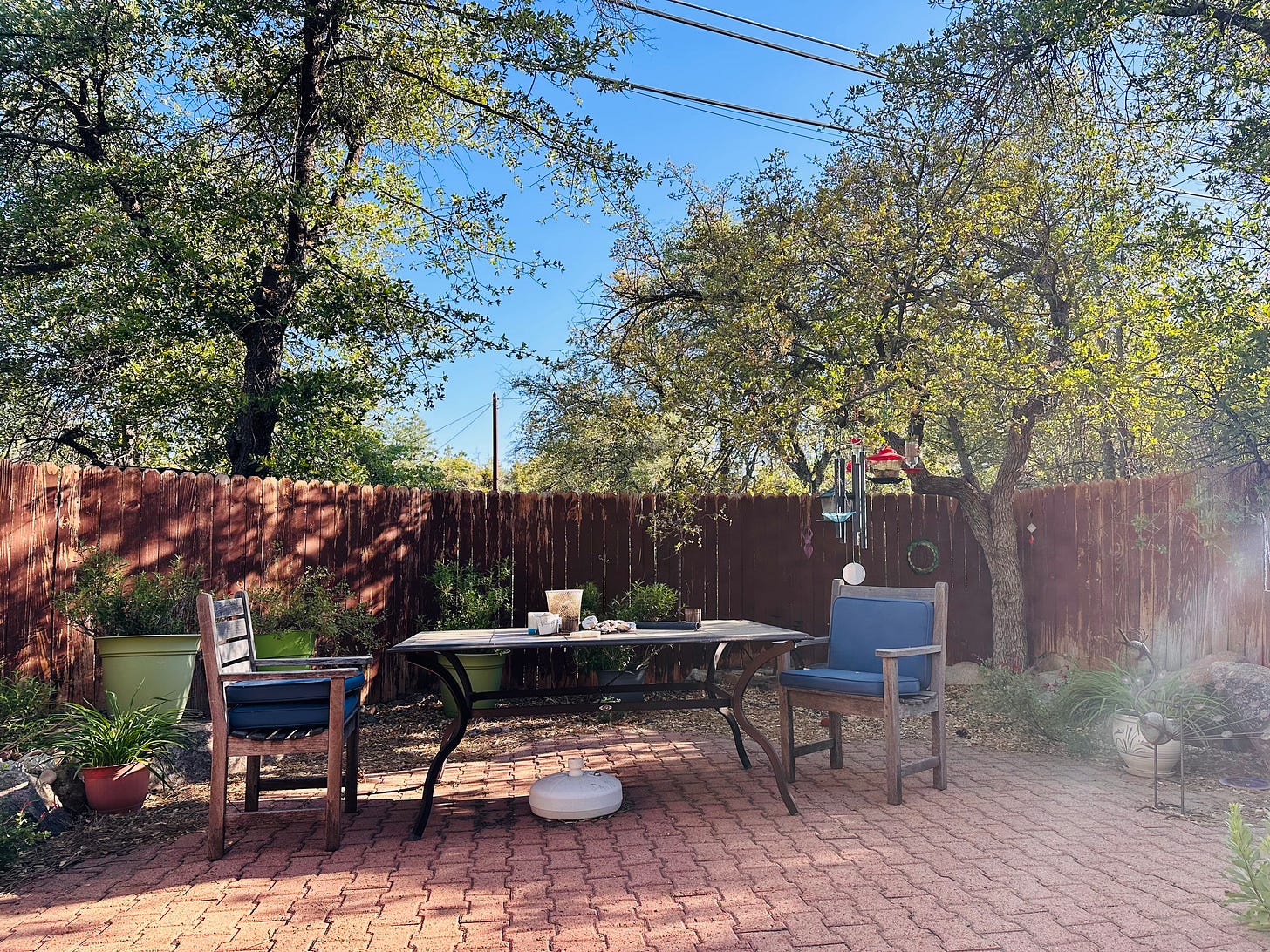
I'm envisioning a phone app like the one you mentioned in another article (the guided birding tour?) that recognizes bird sounds. Bird translation app sounds incredible. I bet they know when it's going to rain and whatnot too.
That bit about the birds knowing about a predator stalking you before you know it is incredible. Haha maybe most of what we hear from birds in the forest is "watch out! human!"